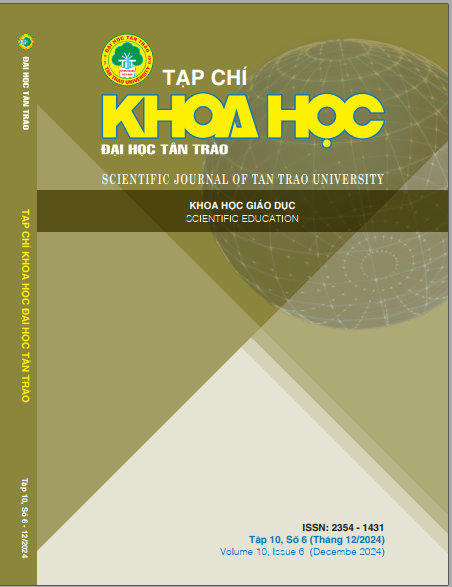TỔNG QUAN NGHIÊN CỨU VỀ TÁC ĐỘNG CỦA CÂY XANH ĐỐI VỚI SỨC KHỎE TÂM LÝ TRONG MÔI TRƯỜNG GIÁO DỤC ĐẠI HỌC
DOI:
https://doi.org/10.51453/2354-1431/2024/1276Tóm tắt
Bài báo này nghiên cứu tác động của cây xanh đối với sức khỏe tâm lý trong môi trường giáo dục đại học, với mục tiêu tổng hợp kết quả các nghiên cứu trong và ngoài nước về vai trò của cây xanh, đồng thời đánh giá các phương pháp nghiên cứu đã được áp dụng và đưa ra định hướng cho các nghiên cứu tiếp theo. Phương pháp nghiên cứu sử dụng là tổng quan tài liệu, thu thập từ các cơ sở dữ liệu khoa học uy tín, lựa chọn và phân tích các nghiên cứu liên quan đến tác động của cây xanh đến sức khỏe tâm lý, đặc biệt là trong môi trường giáo dục đại học. Kết quả cho thấy cây xanh có tác dụng tích cực trong việc giảm căng thẳng, lo âu, đồng thời tăng cường sự tập trung và hiệu quả học tập. Các nghiên cứu quốc tế và trong nước đều khẳng định cây xanh giúp cải thiện không gian học tập, giảm mức độ stress và nâng cao chất lượng học tập cho sinh viên. Kết luận từ nghiên cứu cho thấy việc phát triển không gian xanh trong khuôn viên các trường đại học không chỉ hỗ trợ sức khỏe tâm lý mà còn góp phần cải thiện chất lượng môi trường học tập, tạo điều kiện cho sinh viên và giảng viên làm việc hiệu quả hơn.
Tải xuống
Tài liệu tham khảo
Brown, T., & Davis, E. (2023). The psychological benefits of plant exposure in university students. Journal of Environmental Psychology, 81,90-103.
https://doi.org/10.1016/ijenvp.2023.03.QQ5
Green, J., & Jones, E. (2023). The role of urban forests in enhancing air quality and mitigating climate change. Urban Forestry & Urban Greening.
https://doi.org/10.1016/j.ufug.2023.03.009
Jones, M., & Williams, S. (2022). Biophilic design: Integrating nature into workspaces for enhanced well-being and productivity. Journal of Environmental Psychology.
https://doi.org/10.1016/jjenvp.2022.101356
Muller, K., & Schmidt, A. (2023). Smart green walls: Integrating technology and plants for urban air purification. Journal of Environmental Management.
https://doi.org/ 10.1016/j j envman.2023.113498
Thompson, S., & Green, D. (2022). Cooling the city: Urban tree canopy and its role in reducing heat island effect. Urban Climate.
https://doi.org/10.1016/i.uclim.2022.100760
White, M., & Thompson, S. (2022). Greening the mind: The impact of urban green spaces on mental health and well-being. Environmental Research. https://doi.org/10.1016/i.
envres.2022.113412
Phạm, M. A. (2012). The role of green plants in reducing stress and enhancing concentration for students (Master’s thesis, University of Social Sciences and Humanities).
Trần, T. H. (2019). Green plants and their impact on mental health in the workplace (Master’s thesis, Hanoi Pedagogical University).
Nguyễn, V. H. (2020). The impact of green plants on the development of soft skills and mental health of students (Master’s thesis, University of Technical Pedagogy in Ho Chi Minh City).
Vũ, Đ. K. (2017). Green plants and their impact on air quality in Hanoi s urban areas (Master’s thesis, University of Architecture Hanoi).
Trần, T. Q. (2021). Green space and its impact on the learning ability of high school students in Hanoi (Master’s thesis, University of Education, Vietnam National University Hanoi).
Tải xuống
Đã Xuất bản
Cách trích dẫn
Số
Chuyên mục
Giấy phép

Tác phẩm này được cấp phép theo Giấy phép Quốc tế Creative Commons Attribution-ShareAlike 4.0 .
Bài báo được xuất bản ở Tạp chí Khoa học Đại học Tân Trào được cấp phép theo giấy phép Ghi công - Chia sẻ tương tự 4.0 Quốc tế (CC BY-SA). Theo đó, các tác giả khác có thể sao chép, chuyển đổi hay phân phối lại các bài báo này với mục đích hợp pháp trên mọi phương tiện, với điều kiện họ trích dẫn tác giả, Tạp chí Khoa học Đại học Tân Trào và đường link đến bản quyền; nêu rõ các thay đổi đã thực hiện và các nghiên cứu đăng lại được tiến hành theo cùng một bản quyền.
Bản quyền bài báo thuộc về các tác giả, không hạn chế số lượng. Tạp chí Khoa học Tân Trào được cấp giấy phép không độc quyền để xuất bản bài báo với tư cách nhà xuất bản nguồn, kèm theo quyền thương mại để in các bài báo cung cấp cho các thư viện và cá nhân.
Mặc dù các điều khoản của giấy phép CC BY-SA không dành cho các tác giả (với tư cách là người giữ bản quyền của bài báo, họ không bị hạn chế về quyền hạn), khi gửi bài tới Tạp chí Khoa học Đại học Tân Trào, tác giả cần đáp ứng quyền của độc giả, và cần cấp quyền cho bên thứ 3 sử dụng bài báo của họ trong phạm vi của giấy phép.






